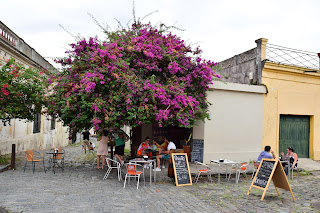Today our port is Montevideo, Uruguay. The skyline had a particularly interesting building shaped like a sail.
The harbor also had a fleet of derelict boats...some nearly sunk.
For our shore excursion today we took a two hour drive through the countryside to Colonia del Sacramento. The drive was through green hills, dairy farms, and farmland. The major economic driver in Uruguay is beef and agriculture.
Founded by the Portuguese, Colonia was the first capital of Uruguay and is a UNESCO World Heritage Site. The Portuguese founded the town to claim this area and prevent Spain from claiming it. Buenos Aires is relatively close, across the river, and the Spanish felt that it encroached upon their territory. So the town changed hands many times before it finally ending up as part of the Spanish colonies. It was originally supposed to be a state in Argentina but eventually became an independent country.
The old town was small and very walk-able with cobblestones, tree lined streets and sidewalk cafes.
The harbor also had a fleet of derelict boats...some nearly sunk.
For our shore excursion today we took a two hour drive through the countryside to Colonia del Sacramento. The drive was through green hills, dairy farms, and farmland. The major economic driver in Uruguay is beef and agriculture.
Founded by the Portuguese, Colonia was the first capital of Uruguay and is a UNESCO World Heritage Site. The Portuguese founded the town to claim this area and prevent Spain from claiming it. Buenos Aires is relatively close, across the river, and the Spanish felt that it encroached upon their territory. So the town changed hands many times before it finally ending up as part of the Spanish colonies. It was originally supposed to be a state in Argentina but eventually became an independent country.
The old town was small and very walk-able with cobblestones, tree lined streets and sidewalk cafes.
The main square had a small market set up with the vendors selling tourist goods.
The town is located on the Rio de la Plata River. The river is 180 miles long and 140 miles wide at the mouth (yes, that isn't a typo...140 miles - the widest mouth of any river in the world). We couldn't see across the river when we were walking along the shore. We did see some people fishing.
The original gate and much of the wall is still standing.
The town has buildings in both Spanish and Portuguese architecture as it changed hands several times. The Portuguese houses have much smaller doors.
The Spanish made their doors much taller so that they could ride their horses through the door into the house's interior courtyard.
Besides the old historic buildings the Historic Quarter also had a number of very old cars parked around the streets. One was turned into a garden...
a couple were sitting outside a restaurant and were outfitted to look like they were ready for diners.
And the driver and passenger in the one in front of the aquarium were large fish.
The cars made for very interesting street art.
The Basilica of the Holy Sacrament was very simple with minimal décor, unlike many of the other churches we have seen in South America.
Apparently in many of the other churches the décor was done by the local indigenous people who had been enslaved by the Spanish and Portuguese conquerors. However, the Europeans were never able to subdue the local indigenous people of Uruguay so the tribes were exterminated. Consequently, the Europeans had no one to do the carvings and paintings common in other South American churches, hence the simplicity of this church.
There were lovely gardens and several large trees with vivid red flowers. These trees are Ceibo (Erythrina Cristogalli for the nerdy types), which is the Uruguayan national flower.
Someone let us take a picture of their cup of mata. It is an extremely popular drink in South America. It an herbal drink that is high in caffeine and is prepared in a special mata cup found in all the shops. It is drunk through a straw fitted with a strainer/filter on the end to keep the herbs in the cup. Didn't even begin to look tasty.
Today is our last full day on our cruise. Tomorrow we arrive in Buenos Aires and the end of our cruise. It has been a magnificent cruise.























No comments:
Post a Comment